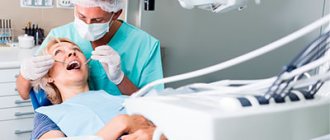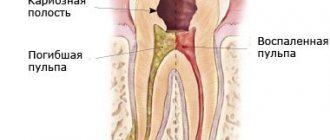A high-quality and rapid wound healing process after tooth extraction depends not only on the professionalism of the doctor who performed the extraction (removal) of the tooth, but on the correct behavior of the patient after the procedure, who must strictly follow the recommendations given by the doctor for the period of healing of the wound surface. If you correctly and clearly follow the advice of a specialist, the recovery process occurs quickly and as painlessly as possible.
For example, patients who do not listen to the recommendations given to them make rinsing movements in the area of the healing wound; this washes out the blood clot, which performs a protective function against the entry of bacteria and microbes, as a result of which there is a high risk of wound suppuration.
In this article we want to give recommendations on what should and can be done after tooth extraction, and what should not be done.
1. A gauze swab on the hole. When can it be taken out?
As a rule, the doctor does not immediately release the patient after removal, but asks him to wait for 15-20 minutes within the clinic to then examine and make sure that everything is in order with blood clotting and the tampon can be removed without fear. In rare cases, keeping the tampon in your mouth may take 30-40 minutes, usually 10-20 minutes. There is no need to keep it longer and it is even dangerous, because bacteria accumulate on it and there is a possibility of infection. There are exceptions, when the wound continues to bleed a little, then the old tampon is replaced with a new sterile one and kept for some time.
For some time, saliva may still be pinkish due to staining with secreted ichor, this should not be alarming, this situation can be distinguished from bleeding. At this moment, saliva can be easily swallowed; there is no need to accumulate it in the mouth.
Instructions for use
When relieving tooth pain, Ketorol is used taking into account certain rules:
The best remedy for toothache
- The dosage of the drug is calculated separately for each specific case, depending on the patient’s body weight and the severity of the symptoms of the disorder.
- It is allowed to take no more than 10 mg of the drug at a time. The maximum daily dosage of Ketorol is 40 mg.
- Use the medication in minimal dosages to relieve dental pain in patients under 18 and over 65 years of age.
- To quickly eliminate discomfort, use the product in the form of injections for injections. How long does it take for the drug to work? The effect of using the solution is observed after 15–20 minutes. Ketorol in tablet form acts within 30–40 minutes.
- During treatment, exclude fatty foods from your diet. It can reduce the rate of absorption of the active substance in the intestine.
Children under 16 years of age are prohibited from taking Ketorol for toothache. But with the permission of the doctor, injections can be used to relieve severe pain. Children are administered the solution intramuscularly in minimal dosages.
2. After what time can you eat and drink?
After removal, you can drink water. After two hours you can eat. The limiting condition is not to chew rough food on the side of the extracted tooth in the first few days. Hard food can damage the blood clot, which is located in the socket and is needed for wound healing. If the patient experiences an acute feeling of hunger, then no one forbids eating cool yogurt or kefir. In the first days of healing of the hole, it is better to completely avoid eating rough, hard, solid foods, so as not to make strong chewing movements, as well as spicy, salty foods, so as not to irritate the oral mucosa. It is also important to monitor the temperature of food and drinks; they should not be too hot.
Proper oral care after tooth extraction
To prevent unwanted consequences from occurring, it is important not to do the following:
- touch the wound with your tongue or use other foreign objects for this,
- rinse your mouth generously in the first two days,
- make sudden movements with the facial muscles,
- plunge into hot water or rinse with it,
- Hard to work,
- eat food in the first 3 hours that follow the procedure, it is permissible to drink, but refrain from boiling water.
- You should also abstain from cigarettes at this time,
- alcohol is contraindicated within 24 hours after surgery. If your doctor prescribes the use of antibiotics, you should not drink alcohol until the end of the course of therapy.
3.Applying ice.
After tooth extraction in our Center, a specialist will give you ice specially prepared for such procedures to apply in the first hours after extraction. Ice is applied for a certain time, at certain intervals, which the doctor will instruct you about. At home, this procedure will need to be continued for some time (the first few hours after removal). This is done in order to minimize or completely eliminate tissue swelling.
Under no circumstances should you heat the area in the area of the extracted tooth; in this case, suppuration will develop.
A cold compress will prevent swelling
Immediately after the manipulations, it is necessary to apply a cold compress, since after tooth extraction the cheek may swell.
To do this, take some chilled meat products or ice and apply it, after wrapping it in a cloth. Such actions will help to minimize or even eliminate swelling of the soft areas of the face that can form in the event of a serious intervention.
It is recommended to keep the ice for about 5 minutes, apply it 3-4 times, taking a break between applications. It is important to apply cold immediately after surgery, since further this action will not bring the desired effect. Under no circumstances should you use a warm compress or warm the tissue in any other way - thoughtless intervention can cause suppuration.
6. Medications after removal.
After the procedure, the doctor prescribes a number of medications to take. Under no circumstances should you take any medications on your own, without consulting a doctor.
Painkillers should be taken in case of pain, at intervals and in the amount recommended by the doctor. Each case is individual; it happens that the patient does without taking painkillers.
Antibiotics. In some cases, after removal, antibiotics are prescribed for 5-7 days. As a rule, these are situations when the doctor removes a tooth in the stage of inflammation, complex extraction or removal of several units of teeth. Only a specialist surgeon decides whether to take antibiotics or not.
Antihistamines. Reduces the likelihood of swelling.
Antiseptics. Used as a rinse. BUT, remembering that rinsing movements are prohibited in the first days. A small amount of solution is taken into the mouth and simply held in the mouth, then calmly spit out. Such baths must be done if the tooth was removed during the inflammation phase, if the flux was exposed, if there are teeth affected by caries in the oral cavity.
If your gums hurt after tooth extraction
Tooth extraction leads to damage to soft tissues, which contain a large number of nerves. The doctor performs the procedures under local anesthesia, so the patient feels discomfort only in one thing - the need to spend a certain amount of time with his mouth wide open.
When the analgesic effect ends and the tooth has already been removed, the pain returns. Usually they are of a “aching” nature and do not fundamentally interfere with normal life activities. But in some cases the pain can be intense.
If the tooth extraction was not caused by inflammatory processes, you can avoid the use of painkillers. If pain relief is necessary to avoid severe pain after tooth extraction, it is recommended to take an analgesic until the anesthetic wears off.
Using painkillers after tooth extraction
If you experience intense pain, you can resort to using “Ketans”; The medicine is dispensed by pharmacists in pharmacies only with a prescription - this is due to the presence of side effects. Severe pain can occur during complex and lengthy medical intervention, especially if it was accompanied by drilling of the bone around the tooth, or if the operation was performed poorly, unprofessionally and traumatically.
“Ketorol” (an analogue of “Ketanov”), “Analgin” (will help reduce mild pain syndrome), “Spazmalgon” (in addition to the analgesic effect has an antiseptic effect), “Baralgin” (a drug that contains “Analgin” in its composition).
7.High blood pressure.
In patients with high blood pressure, there is a risk that the wound may bleed longer than usual. In this case, you need to regulate the pressure by taking appropriate medications to reduce it. In our SDent dental medical center, even before the start of manipulations, the doctor always finds out the main points about the general health of the patient. If the patient has hypertension, the specialist knows about this problem in advance and then gives the necessary recommendations appropriate to the case.
Wisdom tooth removal
Wisdom teeth are the painter or chewing teeth located at the end. When chewing, they do not play a significant role; the structure is no different from ordinary teeth.
There are several generally accepted indications for removal:
- ingrowth of roots into the maxillary sinus,
- partial eruption
- facial neuralgia,
- inclined or lateral position,
- caries damage.
When removing a wisdom tooth, painkillers are used to relieve pain. Consequences after the operation may occur depending on the complexity of the operation, surrounding tissues, location, and access to the tooth.
Negative consequences may occur if the patient does not adhere to the doctor's orders. Baths of soda and herbal decoctions will also help alleviate the condition after removal. It is forbidden to rinse; it is important to preserve the blood clot, which protects the wound from infection.
8.What happens to the sutures after removal.
After the tooth is removed, the surgeon places sutures on the wound surface. This promotes faster healing, reduced pain, less risk of inflammation, minimizes the risk of bleeding, and protects the blood clot from falling out.
At the SDent clinic we use the most modern and safe materials. The thread with which the surgeon sews the edges of the hole is self-absorbing. But during the process, the ends of the thread can cause discomfort to the patient and interfere with the oral cavity. Therefore, for the comfort and safety of the patient, the doctor always sets an appointment date for examination and removal of sutures in approximately 10 days.
If your gums bleed after tooth extraction
You can stop bleeding in a number of effective ways. In most cases, this disease affects people with high blood pressure with hypertension or patients who have had a large vessel damaged.
It is worth noting that due to psychological overload and stress during activities, even in people with normal health, blood pressure may rise. The first step is to apply a tightly rolled piece of sterile bandage to the bleeding site, and then measure the patient’s blood pressure. If it is elevated, you need to resort to medications.
With increased blood pressure, the chance of hematoma and blood appearing after tooth extraction increases. This development of events is dangerous due to suppuration, which will then have to be opened, and bleeding can cause dizziness and weakness.
If bleeding appears several hours after removal, you should not wait for the situation to normalize, but seek medical help.
Diabetes mellitus during tooth extraction
If a person has this disease, it is recommended to measure their sugar levels immediately after surgery. Tension leads to the production of adrenaline, which can increase the rate. By measuring sugar, a person will know about his condition and will be able to prevent side effects.
If a gauze pad is placed on the gum
A gauze swab is placed on the hole if it is etching. In other situations, the use of this remedy is undesirable, as it can provoke inflammation. As the tissue is removed, the blood clot that has formed in the socket is also removed.
If the tissue lining is on the wound, it is necessary to carefully remove it after a certain period of time after removing the tooth. A tampon that has absorbed a certain amount of liquid automatically becomes a breeding ground for a wide range of bacteria. You should not keep it in your mouth for a long time to prevent the appearance of inflammatory processes in the hole that remains after tooth extraction.
Antiseptic rinses for suppurations
There is no need to rinse your mouth intensively; instead, use “baths”. In order not to disturb the damaged tissues, take a special anti-inflammatory solution into your mouth, keep it inside, and then spit it out.
After tooth extraction, you should not do the following.
- In the first couple of days, taking a hot bath is excluded, only a warm shower.
- During sleep, you need to be careful not to lie on the side where the tooth was removed, this provokes the appearance of swelling.
- Visiting the gym and active physical activity should be postponed in the first days.
- Do not touch the wound with your tongue or foreign object.
- Do not open your mouth very wide, do not use active chewing and facial movements to avoid the sutures coming apart.
- Aspirin is not suitable as an anesthetic due to the fact that it has a thinning effect on the blood and may cause bleeding and hematoma.
- Do not rinse during the first few days. This can negatively affect the loss of a blood clot from the socket and the occurrence of inflammation.
For more information and to make an appointment with a specialist, call:
+7,
Indications for use for toothache
Ketorol is taken for toothaches manifested due to:
- medium form of caries;
- pulpitis;
- dental granulomas;
- osteomyelitis;
- maxillofacial injuries;
- cysts;
- flux;
- tooth extraction;
- pericoronitis,
- implantation or other surgical intervention.
Taking Ketorol in tablets or ampoules for more than 5 days is not recommended.
If the drug helps relieve toothaches, you should still consult a dentist. There is a high probability that discomfort will appear in the near future and will manifest itself with a greater degree of severity.
After implantation and surgical intervention, medicine containing ketorolac is also allowed to be taken for no more than 5 days. If after surgery the pain does not subside or intensifies, you should make an appointment with a specialist again. Severe discomfort after the intervention may be associated with the addition of a secondary infection to the problem area. In this case, Ketorol is useless.
In what cases is it necessary to remove the nerve of a tooth?
Removing the nerve from a tooth kills it. Almost no nutrients are supplied, causing it to become darker and weaker. During treatment, dentists try to keep the dental nerve alive, but sometimes they have to take forced measures to put the oral cavity in order.
Nerve removal is necessary if:
- Deep caries.
If the disease has destroyed almost the entire tooth, there is nothing to save; the main thing for the doctor is to prevent further destructive process.
- Prosthetics.
To install the prosthesis, an incision must be made in the pulp chamber. This is especially necessary in situations where teeth grow at an inclined angle.
- Incorrect treatment in the past.
This can happen if during treatment the doctor resorted to opening the pulp chamber. In this case, it is necessary to partially remove the nerve.
- Mechanical damage.
Injury can lead to chips in the enamel where the nerve is located. If the front teeth are damaged, the nerve is not completely removed.
Antibiotic therapy after removal of unhealthy teeth
Antibiotics are prescribed by the attending physician - dentist. Drugs are prescribed in case of difficult extraction, to prevent the risk of complications if the tooth was removed due to inflammatory processes.
The drug usually prescribed is Lincomycin 0.25. Take capsules after tooth extraction for 5 days, 2 capsules 3 times. If purulent inflammation is present, the antibiotic is prescribed as intramuscular injections.
Those who suffer from intestinal and stomach disorders can take antibiotics in effervescent forms, for example, Unidox Solutab and Flemoxin Solutab.










